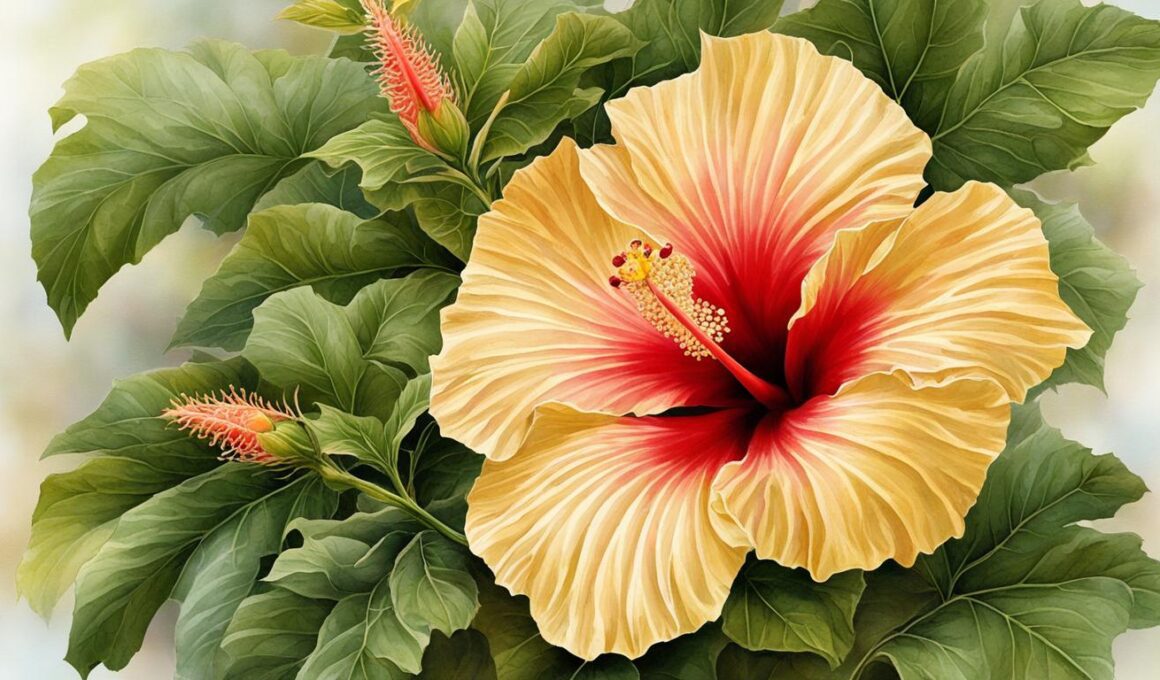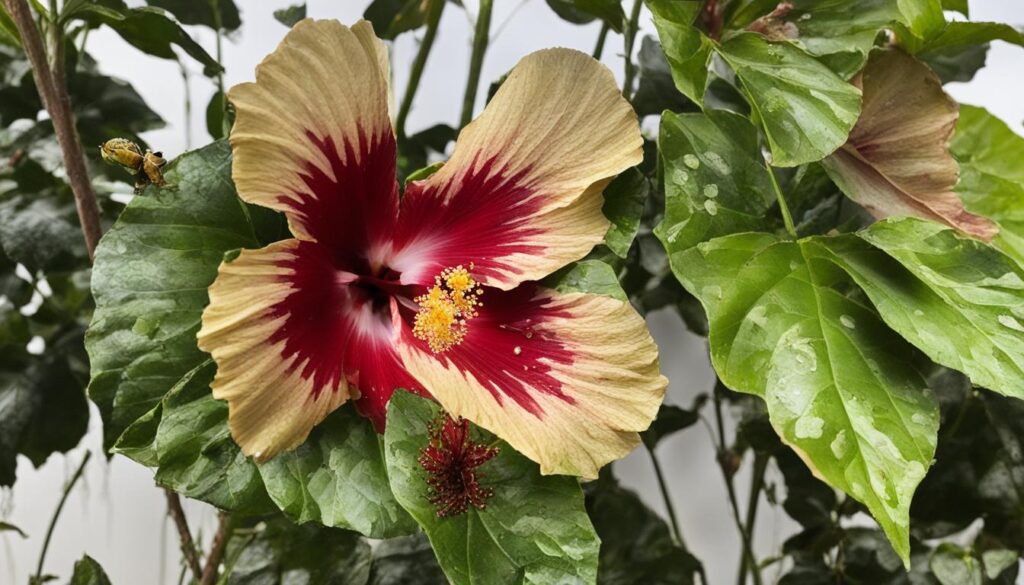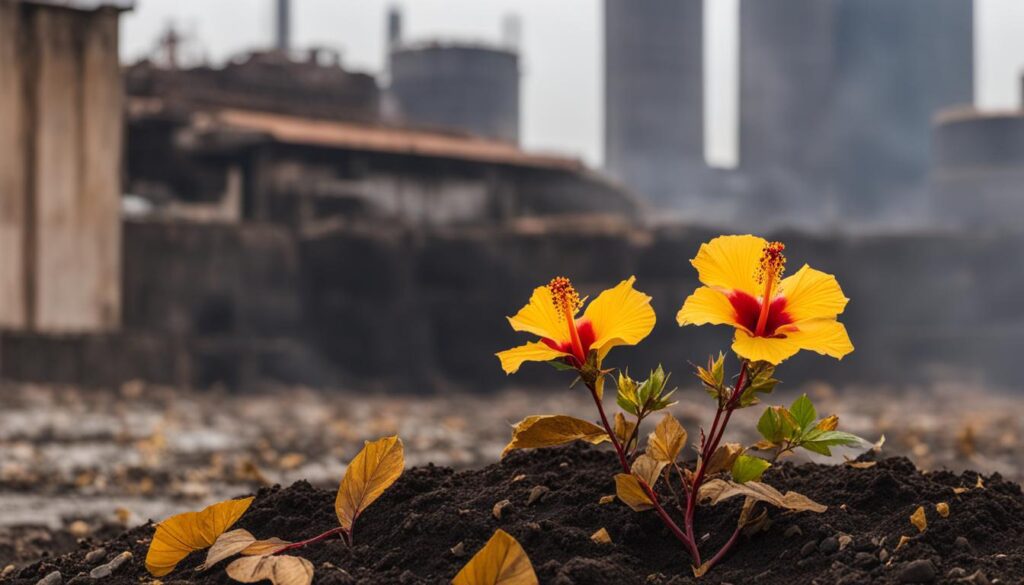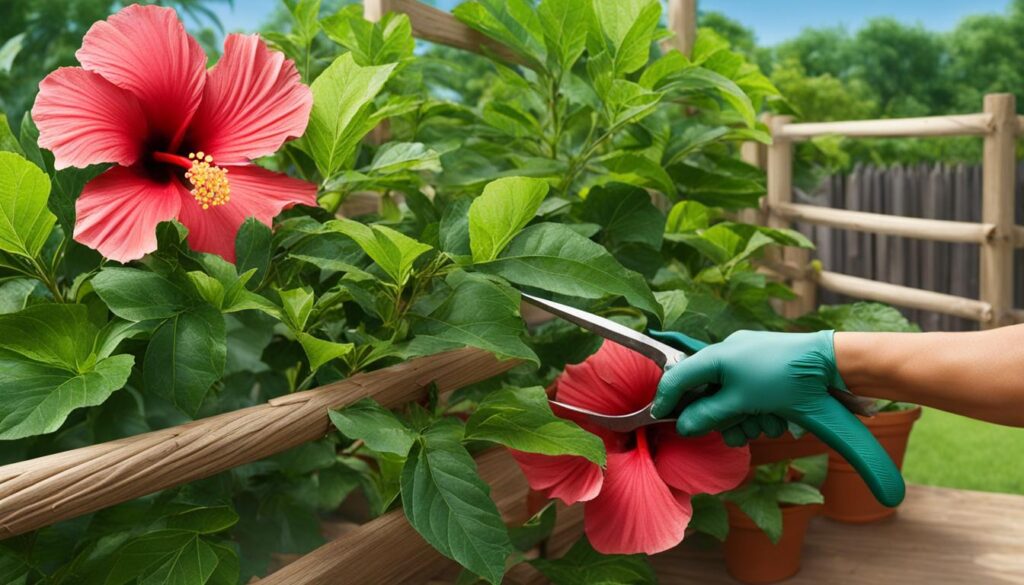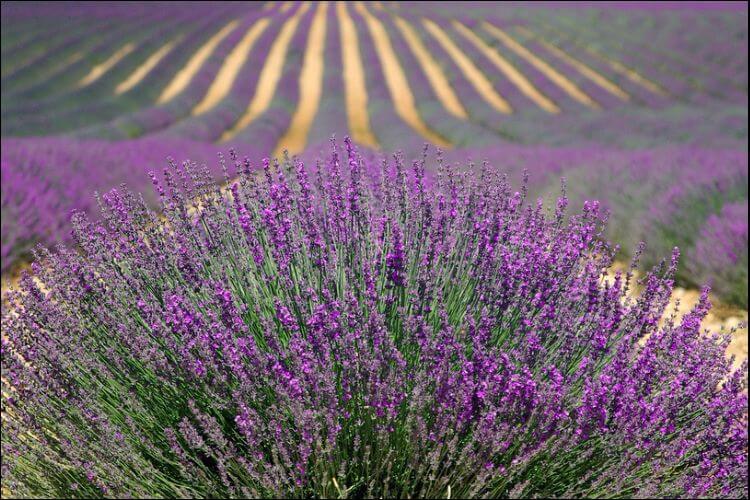If you’re a gardener who loves hibiscus plants, it’s important to be familiar with the potential diseases that can affect these beautiful flowers. Hibiscus plants, belonging to the Hibiscus spp. family in the Malvaceae family, are known for their stunning blossoms in a variety of colors. However, like any plant, hibiscus can fall victim to diseases that can impact their health and vitality.
To effectively diagnose and treat hibiscus plant diseases, it’s essential to understand the common issues that can arise. In this section, we’ll explore a range of diseases that can affect hibiscus plants, including their identification, prevention, and treatment methods.
Key Takeaways
- Hibiscus plants are susceptible to various diseases that can impact their health and appearance.
- Diagnosing and treating hibiscus plant diseases require knowledge of the specific symptoms and identification techniques.
- Preventing hibiscus plant diseases involves providing optimum growing conditions and maintaining good hygiene practices.
- Treating hibiscus plant diseases may involve applying targeted treatments and implementing cultural practices.
- Promoting overall plant health is the key to preventing and managing hibiscus plant diseases effectively.
Common Pests of Hibiscus Plants
Hibiscus plants are beautiful additions to any garden, but they can be susceptible to a range of pests that can cause damage and hinder their growth. In order to keep your hibiscus plants healthy and vibrant, it’s important to be aware of common pests and take appropriate measures to control them.
Aphids:
Aphids are small, soft-bodied insects that can infest hibiscus plants. They are typically found on new growth and the undersides of leaves. Aphids feed on plant sap, which can lead to distorted leaves, stunted growth, and the secretion of a sticky substance known as honeydew. Regular inspection and insecticidal soap or neem oil sprays can help control aphid populations.
Mealybugs:
Mealybugs are another common pest of hibiscus plants. These small, white, cottony insects infest the leaves, stems, and flower buds of the plant. Mealybugs suck sap from the plant, causing yellowing, distortion, and stunted growth. To control mealybugs, you can use a cotton swab dipped in rubbing alcohol to remove them manually or apply insecticidal soap or horticultural oil.
Soft Scales:
Soft scales are small, oval-shaped insects that attach themselves to the stems and leaves of hibiscus plants. They feed on plant sap and excrete a sticky substance known as honeydew, which can attract ants and promote the growth of sooty mold. To control soft scales, you can use horticultural oil or insecticidal soap.
Root Knot Nematode:
Root knot nematodes are microscopic roundworms that infect the roots of hibiscus plants. They cause the formation of small, swollen galls on the roots, which can lead to stunted growth, wilting, and nutrient deficiencies. Crop rotation, soil solarization, and the use of resistant plant varieties can help control root knot nematodes.
Whiteflies:
Whiteflies are small, winged insects that can infest hibiscus plants. They feed on the sap of the plant, causing yellowing, wilting, and the development of sooty mold. Whiteflies can reproduce rapidly, so early detection and control measures are essential. Yellow sticky traps, insecticidal soaps, and neem oil sprays can be effective in controlling whitefly populations.
| Pest | Description | Control |
|---|---|---|
| Aphids | Small, soft-bodied insects that feed on plant sap | Insecticidal soap or neem oil sprays |
| Mealybugs | Small, white, cottony insects that infest leaves, stems, and flower buds | Manual removal or insecticidal soap or horticultural oil |
| Soft Scales | Small, oval-shaped insects found on stems and leaves | Horticultural oil or insecticidal soap |
| Root Knot Nematode | Microscopic roundworms that infect the roots | Crop rotation, soil solarization, and resistant varieties |
| Whiteflies | Small, winged insects that feed on sap and reproduce rapidly | Yellow sticky traps, insecticidal soap, and neem oil sprays |
Common Diseases of Hibiscus Plants
Hibiscus plants are vulnerable to various diseases that can impact their overall health and appearance. Understanding and recognizing these common diseases is crucial for effective prevention and treatment. Some of the most prevalent diseases of Hibiscus spp. include armillaria root rot, bacteria leaf spots, botrytis blight, root and crown rots, and viruses.
Armillaria root rot is a fungal disease that affects the roots of hibiscus plants. It causes the roots to decay, leading to wilting, stunted growth, and ultimately, the death of the plant. Identifying and treating this disease early is vital to prevent further damage.
Bacteria leaf spots are another common problem for hibiscus plants. These leaf spots appear as discolored areas on the leaves and can be caused by various bacteria. Infected leaves may develop lesions or fall off prematurely, affecting the plant’s overall health and aesthetic appeal.
“Botrytis blight, also known as gray mold, is a fungal disease that affects hibiscus flowers and leaves. It causes the development of tan, papery patches covered in gray, fuzzy masses. This disease can impact the plant’s ability to produce healthy blooms and should be treated promptly to prevent further spread.”
Root and crown rots can occur due to various pathogens, including fungi and bacteria. These diseases manifest as decay or rotting of the roots and base of the plant. Symptoms may include wilting, yellowing leaves, and gradual decline of the plant’s overall health.
Hibiscus plants are also susceptible to viral infections. Viruses like the hibiscus chlorotic ringspot virus can weaken the plant’s immune system and disrupt its normal growth and development. It’s important to promptly identify and manage viral infections to prevent further spread.
| Disease | Symptoms | Treatment |
|---|---|---|
| Armillaria Root Rot | Wilting, stunted growth, root decay | Improve drainage, remove infected roots, apply fungicides |
| Bacteria Leaf Spots | Discolored spots on leaves, lesions, leaf drop | Remove infected leaves, improve air circulation, apply copper-based bactericides |
| Botrytis Blight | Tan, papery patches covered in gray, fuzzy masses | Remove infected plant parts, improve air circulation, apply fungicides |
| Root and Crown Rots | Root decay, wilting, yellowing leaves | Improve drainage, remove infected roots, apply fungicides |
| Viruses | Stunted growth, leaf discoloration, distorted leaves | Remove infected plants, control insect vectors, maintain plant health |
Environmental Disorders of Hibiscus Plants
Hibiscus plants, like any other plant, can be affected by environmental disorders that impact their growth and overall health. These disorders include mineral deficiencies, nutrient and mineral excesses, and poor water management. Understanding these disorders and their potential effects is crucial for maintaining the well-being of your hibiscus plants.
One common environmental disorder is mineral deficiencies. When hibiscus plants lack essential minerals, such as iron or nitrogen, they may exhibit symptoms like yellowing leaves or stunted growth. It’s important to regularly monitor your plants for any signs of mineral deficiencies and take appropriate action to replenish the missing nutrients.
On the other hand, nutrient and mineral excesses can also be detrimental to hibiscus plants. Excessive levels of certain minerals, such as phosphorus or potassium, can lead to toxicity and cause symptoms like leaf discoloration or even plant death. It’s crucial to provide your hibiscus plants with balanced fertilization and avoid over-application of nutrients to prevent nutrient excesses.
Poor water management is another environmental disorder that can negatively impact hibiscus plants. Watering your plants too much or too little can lead to root rot, wilting, and overall decline. It’s important to maintain proper watering practices, ensuring that the soil is well-drained and that your plants receive adequate moisture without being waterlogged.
| Environmental Disorder | Symptoms | Prevention |
|---|---|---|
| Mineral deficiencies | Yellowing leaves, stunted growth | Regularly monitor nutrient levels, apply appropriate fertilizers |
| Nutrient and mineral excesses | Leaf discoloration, toxicity symptoms | Provide balanced fertilization, avoid excessive application of nutrients |
| Poor water management | Root rot, wilting, decline | Maintain proper watering practices, ensure good drainage |
By understanding and addressing these environmental disorders, you can help ensure the optimal growth and health of your hibiscus plants. Regularly inspect your plants for any signs of deficiency or excess, and take appropriate measures to correct the imbalance. With proper care and attention, your hibiscus plants can thrive and reward you with their beautiful blooms.
Disease Prevention for Hibiscus Plants
Preventing diseases in hibiscus plants is crucial for their health and vitality. By implementing proper disease prevention methods, you can ensure that your hibiscus plants have vigorous growth and remain disease-free. Here are some key strategies to consider:
Promote Vigorous Growth
One of the most effective ways to prevent diseases in hibiscus plants is to promote vigorous growth. This can be achieved by providing optimal conditions for the plant’s development. Ensure that your hibiscus plants receive adequate sunlight, nutrients, and water. Regularly monitor their growth and address any issues promptly. By creating an environment that supports healthy growth, you can help your hibiscus plants resist diseases.
Maintain Good Hygiene
Good hygiene practices are essential for preventing diseases in hibiscus plants. Remove spent flowers regularly to prevent the buildup of pathogens. Use clean pruning tools when trimming your plants to avoid introducing infections. Additionally, practice proper watering techniques to minimize the risk of fungal diseases. By maintaining good hygiene in your hibiscus garden, you can reduce the likelihood of diseases spreading among your plants.
Keep Hibiscus Plants Pest-Free
Pests can often be carriers of pathogens that can cause diseases in hibiscus plants. To prevent the spread of diseases, it’s important to keep your plants pest-free. Monitor your hibiscus plants regularly for signs of infestation, such as aphids or whiteflies. If you notice any pests, employ appropriate control methods, such as insecticides or biological controls, to eliminate them. By keeping pests at bay, you can protect your hibiscus plants from potential diseases.
By incorporating these disease prevention methods into your hibiscus plant care routine, you can ensure that your plants remain healthy and vibrant. Remember to promote vigorous growth, maintain good hygiene, and keep pests under control. By taking proactive measures, you can enjoy beautiful, disease-free hibiscus plants in your garden.
Disease Treatment for Hibiscus Plants
If you notice wilted leaves on your hibiscus plant, it’s important to take immediate action. Wilting can be a symptom of several diseases, including dieback disease or wilt disease. If only one branch or part of the plant is affected, it may be a case of dieback disease, which is treatable. However, if all the leaves on the plant are wilted, it could be a sign of wilt disease, which is often fatal and requires immediate treatment.
Identifying and treating hibiscus diseases early on can greatly increase the chances of successful treatment and recovery for the plant. By promptly addressing the underlying issue, you can help restore the health and vitality of your hibiscus. It is recommended to consult with a horticulturist or plant expert to accurately diagnose the specific disease and determine the most effective treatment options.
Symptoms such as wilting leaves should not be ignored, as they can serve as warning signs of more serious problems. Regularly inspecting your hibiscus plants for any signs of disease and promptly addressing them can help prevent the spread of infection and minimize the impact on the overall plant health. Remember that prevention is always better than cure, so maintaining optimal growing conditions, practicing good hygiene, and keeping pests under control can go a long way in preventing diseases in the first place.
| Disease Type | Symptoms | Treatment |
|---|---|---|
| Dieback Disease | Wilting leaves on a single branch or part of the plant | Prune and remove affected branches, treat with appropriate fungicides |
| Wilt Disease | Wilted leaves on the entire plant | Remove and destroy infected plants, avoid planting hibiscus in the same area, improve soil drainage |
Fungal Diseases Affecting Hibiscus Plants
Hibiscus plants can be vulnerable to various fungal diseases, including botrytis blight, also known as gray mold. This particular disease primarily affects the flowers, causing tan, papery patches covered in gray, fuzzy masses. It can quickly spread and result in the deterioration of the plant if left untreated. Therefore, it is crucial to implement preventive measures and adopt proper treatment strategies to protect your hibiscus plants from fungal diseases.
To prevent fungal diseases like botrytis blight, good sanitation practices are essential. This involves removing any affected tissues promptly and maintaining proper watering and spacing. Ensuring adequate air circulation around the plant can also help prevent the spread of fungal spores. Additionally, it is crucial to provide your hibiscus plants with optimal growing conditions, such as well-drained soil and proper sunlight exposure.
If your hibiscus plants do develop symptoms of fungal diseases, prompt treatment is necessary. Fungicide sprays can be used to control fungal growth, with various compounds registered for this purpose. However, it is essential to carefully read and follow the instructions provided by the manufacturer to ensure safe and effective application. Regular monitoring and early detection are key to successful treatment and recovery of your hibiscus plants.
| Fungal Disease | Symptoms | Prevention | Treatment |
|---|---|---|---|
| Botrytis Blight (Gray Mold) | Tan, papery patches covered in gray, fuzzy masses on flowers | – Good sanitation practices – Proper watering and spacing – Adequate air circulation |
– Fungicide sprays – Early detection and treatment |
“Preventing and controlling fungal diseases in hibiscus plants is vital to ensure their health and longevity. By practicing good sanitation, providing optimal growing conditions, and promptly treating any signs of fungal diseases, you can protect your hibiscus plants and enjoy their vibrant blooms for years to come.”
Remember that prevention is key when it comes to fungal diseases. By implementing proper sanitation practices, creating favorable growing conditions, and using appropriate treatments, you can effectively manage and control fungal diseases in your hibiscus plants. Regular care and vigilance will help keep your plants healthy and thriving.
Fungal Diseases and Their Impact
Fungal diseases can significantly impact the health and appearance of hibiscus plants. They can lead to the wilting and decay of leaves, flowers, and even the entire plant if not addressed promptly. Additionally, fungal diseases can weaken the plant’s immune system, making it more susceptible to other diseases and pests. Therefore, it is crucial to identify and treat fungal diseases as soon as possible to minimize their impact on your hibiscus plants.
Common Insect Problems for Hibiscus Plants
Hibiscus plants are vulnerable to a variety of insect problems, which can negatively impact their growth and overall health. Being aware of these common pests and understanding how to manage them is essential for maintaining vibrant and thriving hibiscus plants.
Aphids are one of the most common insect problems for hibiscus plants. These small insects feed on the sap of leaves and buds, causing stunted growth and distorted foliage. To control aphid infestations, you can use insecticidal soaps or oils, or introduce natural predators like ladybugs.
Another insect pest that can affect hibiscus plants is the corn earworm. These caterpillars may occasionally cause damage to the flowers of hibiscus plants. Regular monitoring and handpicking can help manage their population and prevent significant damage.
Other insect problems that hibiscus plants may face include:
- Hibiscus sawfly: These pests chew on the leaves of hibiscus plants, causing defoliation and weakening the plant’s overall health.
- Japanese beetle: These beetles feed on the leaves and flowers of hibiscus plants, resulting in skeletonized foliage and reduced blooming.
- Whiteflies: They are tiny, sap-sucking insects that can infest hibiscus plants, causing yellowing leaves and stunted growth.
Effective control methods for these insect problems often include a combination of cultural practices, such as maintaining good plant health and cleanliness, and targeted insecticide applications. Regular monitoring and early intervention are key to preventing and managing insect infestations.
Common Insect Problems of Hibiscus Plants
| Insect | Description | Damage |
|---|---|---|
| Aphids | Small sap-sucking insects | Stunted growth, distorted foliage |
| Corn Earworm | Caterpillars that occasionally feed on flowers | Damage to flowers |
| Hibiscus Sawfly | Larvae that chew on leaves | Defoliation, weakened plant |
| Japanese Beetle | Beetles that feed on leaves and flowers | Skeletonized foliage, reduced blooming |
| Whiteflies | Tiny sap-sucking insects | Yellowing leaves, stunted growth |
Controlling Whiteflies on Hibiscus Plants
Whiteflies, including the greenhouse whitefly, sweetpotato whitefly, and silverleaf whitefly, commonly infest hibiscus plants. These tiny, sap-sucking insects can cause damage to the plants by feeding on the leaves and transmitting viral diseases. To effectively control whiteflies and protect your hibiscus plants, it’s important to implement a combination of prevention and biological control methods.
Prevention:
Preventing whiteflies from infesting your hibiscus plants is the first line of defense. Start by inspecting new plants before bringing them into your garden, as whiteflies can hitch a ride on infested plants. Regularly monitor your hibiscus plants for signs of whitefly presence, such as the tiny, winged adults or the immobile nymphs on the underside of leaves. If you spot any whiteflies, take immediate action to prevent an infestation from spreading.
Biological Controls:
One effective method of controlling whiteflies on hibiscus plants is to introduce natural enemies that feed on whiteflies. Ladybeetles, also known as ladybugs, are voracious predators of whiteflies and can help keep their populations in check. You can attract ladybeetles to your garden by planting nectar-rich flowers or by purchasing them from garden supply stores. Another biological control method is the use of parasitoids, which are tiny wasps that lay their eggs inside whitefly nymphs, ultimately killing them. These natural enemies can provide long-term control of whitefly populations without the need for chemical insecticides.
“Implementing a combination of prevention and biological control methods is crucial in effectively managing whiteflies on hibiscus plants. By taking proactive measures to prevent infestations and introducing natural enemies, you can maintain the health and vitality of your hibiscus plants.”
Comparison of Whitefly Species
| Whitefly Species | Description | Preferred Habitat |
|---|---|---|
| Greenhouse Whitefly | Aleyrodes vaporariorum | Greenhouses and indoor environments |
| Sweetpotato Whitefly | Bemisia tabaci | Outdoor gardens and vegetable crops |
| Silverleaf Whitefly | Bemisia argentifolii | Tropical and subtropical regions |
Gaining a better understanding of the different whitefly species can help you tailor your control measures accordingly. While all whiteflies can be damaging to hibiscus plants, the specific species may have different habitat preferences. By identifying the whitefly species infesting your hibiscus plants, you can implement targeted control strategies to effectively manage the infestation.
Overall, controlling whiteflies on hibiscus plants requires a multi-faceted approach. Stay vigilant in monitoring for whitefly presence, implement preventive measures, and introduce natural enemies to maintain the health and beauty of your hibiscus plants. With proper control measures in place, your hibiscus plants can thrive and flourish, free from whitefly infestations.
Conclusion
Properly diagnosing and treating hibiscus plant diseases is crucial for maintaining the overall health and vitality of your plants. By understanding the types of diseases that can affect hibiscus, implementing preventive measures, and promptly treating any issues that arise, you can help ensure your hibiscus plants thrive and produce vibrant blooms.
Regular monitoring is key to catching any signs of disease early on. By regularly inspecting your plants for symptoms such as wilting leaves, discoloration, or unusual growth patterns, you can address any issues before they become severe.
In addition to monitoring, implementing good cultural practices is essential for disease prevention. This includes providing optimal conditions for your hibiscus plants, such as proper sunlight, nutrient-rich soil, and adequate watering. Maintaining good hygiene, such as removing spent flowers and debris, can also help prevent the spread of diseases.
If you do notice any disease symptoms on your hibiscus plants, prompt treatment is important. Depending on the specific disease, various treatment options may be available, such as using fungicides or insecticides specifically formulated for hibiscus plants. It’s important to carefully follow the instructions on the product labels and reapply treatments as necessary.
By prioritizing disease prevention and timely treatment, you can ensure the overall health and longevity of your hibiscus plants. With proper care and attention, your hibiscus plants will continue to thrive and bring beauty to your garden for years to come.
Can Overwatering or Underwatering Cause Hibiscus Plant Diseases?
Overwatering or underwatering can lead to hibiscus plant diseases. Follow these watering tips for hibiscus: water thoroughly when the soil is dry to touch, but don’t let it sit in water. Provide proper drainage, and avoid watering late in the day to prevent fungal growth.
FAQ
What are the common pests that can affect hibiscus plants?
Common pests of hibiscus plants include aphids, mealybugs, soft scales, root knot nematodes, and whiteflies.
What are the common diseases that can affect hibiscus plants?
Common diseases of hibiscus plants include armillaria root rot, bacteria leaf spots, botrytis blight, root and crown rots, and viruses.
What are some environmental disorders that hibiscus plants can face?
Hibiscus plants can suffer from mineral deficiencies, nutrient and mineral excesses, and poor water management.
What are some methods of disease prevention for hibiscus plants?
Disease prevention for hibiscus plants includes promoting vigorous growth, practicing good hygiene, and keeping the plants pest-free.
How should I treat a hibiscus plant with wilted leaves?
If only one branch or part of the plant is affected, it may be a sign of treatable dieback disease. If all leaves on the plant are wilted, it could be a sign of fatal wilt disease that requires immediate treatment.
How can I prevent and treat fungal diseases affecting hibiscus plants?
Good sanitation practices, proper watering, spacing, and the use of fungicide sprays can help prevent and treat fungal diseases like botrytis blight or gray mold.
What are some common insect problems that hibiscus plants may face?
Common insect problems for hibiscus plants include aphids, corn earworm, hibiscus sawfly, Japanese beetle, and whiteflies.
How can I control whiteflies on hibiscus plants?
Monitoring with yellow sticky traps, employing biological controls, and using insecticidal soaps or oils can help manage whitefly populations on hibiscus plants.
What steps can I take to maintain the overall health of my hibiscus plants?
Regular monitoring, good cultural practices, and proactive disease management can help keep hibiscus plants healthy and disease-free.





